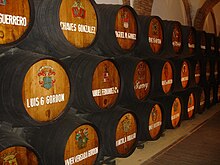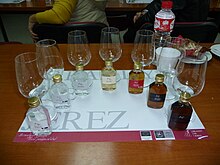Brandy de Jerez

Brandy de Jerez is a protected designation of origin ( DOP ) for a brandy from the region around the Andalusian Jerez (from the sherry triangle between the cities of Jerez de la Frontera , El Puerto de Santa María and Sanlúcar de Barrameda , in the province of Cádiz ). It is sold as brandy and is also a component of some sherries .
history
Moors , who for religious reasons were forbidden to drink the already famous wines of the Jerez region, decided to distill them in order to obtain alcohol not only for perfumes, but also for antiseptic and medicinal purposes. It is not well documented when wine spirits were first aged there in oak barrels to produce schnapps. It is clear that there was a significant amount of alcohol in the sixteenth century, as there is documentary evidence that the councilor of Jerez had a Jesuit school built in 1580 from the proceeds of a municipal alcohol tax .
In the eighteenth and nineteenth centuries, the production of spirits of wine began to consolidate for commercial use and export, especially to the countries of Northern Europe. The Netherlands was the main market and from there it was shipped all over the world.
The name brandy is an English adaptation of the original Dutch word “brandewijn” ( German burned wine ), while the term “Holanda” (name of the low-alcohol wine spirits used in the production of Brandy de Jerez) comes from the name of the Country is derived. The term “Brandavin” was already used in the picaresque literature of the 17th century (for example in The Life and Work of Estebanillo González, Man in a Good Mood ). In the early 19th century, English and French merchants arrived in Jerez and, along with Spanish merchants with clear commercial instincts, began promoting trade and setting the guidelines for the characteristic production and aging process of Brandy de Jerez. In the 19th century brand names for Brandy de Jerez were created on the initiative of sherry companies, which still exist worldwide today.
production
The production uses two different distillation units, both made of copper .
- The traditional pot still , known in Jerez as Alquitara , introduced by the Moors, made from copper and heated directly by a spar oak wood fire using a discontinuous process (loading and unloading). These are used to obtain spirits with a low alcohol content between 40 and 70% by volume. Holandas is the term used in Jerez to refer to these low alcohol spirits that are of greater quality as they require the distillation of the best wines and better elicit the raw material from which they are made.
- Distillation columns that are more modern and efficient, into which the wine is continuously introduced. These columns are used to obtain strengths between 70 and 94.8% by volume.
In the case of Brandy de Jerez, no double distillation is required. Brandy wines of 65% by volume are obtained from a simple distillation. The more often a wine is distilled, the more its properties and aromas are lost.
The traditional production method of Brandy de Jerez is controlled by the Consejo Regulador del Brandy de Jerez (the Brandy de Jerez Regulatory Council). The method has three main features:
- The brandy must have been produced exclusively in the municipal boundaries of Jerez de la Frontera, El Puerto de Santa María and Sanlúcar de Barrameda.
- It has to be aged in American oak barrels with a capacity of 500 liters, which previously contained sherry. Different types of sherry give the brandy an individual note.
- The traditional aging system of criaderas y soleras must be used.
In Jerez it is also possible to use spirits with a higher alcohol content, but never (by decree of the Consejo) more than 50% of the total amount. The Holandas must always make up 50% of the final brandy.
Classification of Brandy de Jerez
The Brandy de Jerez Regulatory Council classifies Brandy de Jerez by age:
- Brandy de Jerez Solera : The youngest and fruity Brandy de Jerez, with an average age of one year and a volatile content in pure alcohol of more than 150 mg / cm³.
- Brandy de Jerez Solera Reserva : Average maturation time of three years and a volatile content in pure alcohol of 200 mg / cm³.
- Brandy de Jerez Solera Gran Reserva : The longest aging with an average of ten years and a content of volatile components in pure alcohol of 250 mg / cm³.
Tourism and Spanish cuisine
The Wine Tourist Route of Sherry Wine and Brandy de Jerez was recently created .
Brandy de Jerez has been used mainly with meat in Spanish cuisine in recent years.
literature
- El Toro de Osborne. Advertising, community, and myth . In: The Social Science Journal . tape 42 , no. 1 , January 2005, p. 135-140 , doi : 10.1016 / j.soscij.2004.11.012 .
- Vicente Fernández de Bobadilla: Brandy de Jerez. SIMPEI SL, Madrid 1994, ISBN 84-605-0278-3 .
Web links
- Consejo Regulador del Brandy de Jerez
- Nobody Expects Spanish Brandy. All that glitters is not Cognac or Armagnac on chow.com
Individual evidence
- ^ Rudolf Prehn GmbH | (Bulk) Wine | Bulk Spirits | Ethyl alcohol. Retrieved June 9, 2017 .
- ↑ Brandy de Jerez . In: Brandy de Jerez . August 4, 2015 ( brandydejerez.es [accessed June 9, 2017]).
- ^ Asociación de la Ruta del Vino y el Brandy del Marco de Jerez: Ruta del Vino y Brandy de Jerez. Retrieved June 9, 2017 (European Spanish).


